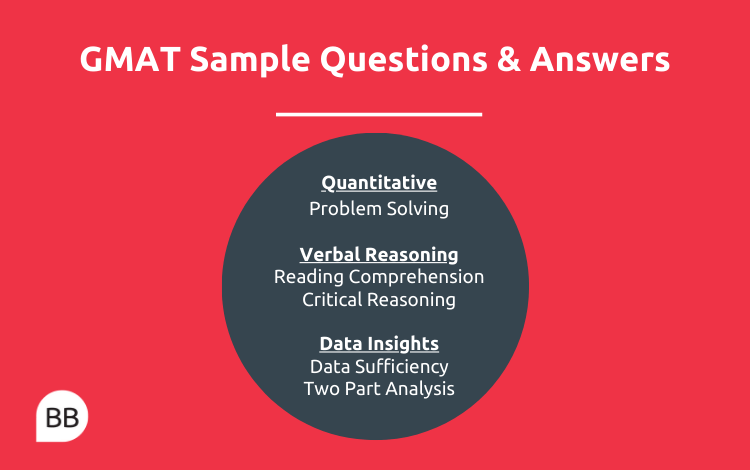Are you preparing for the GMAT? Our GMAT sample questions and answers are from GMAC (Graduate Management Admission Council), the makers of the exam.
Whether you’re about to take the GMAT online or in a test center, or even if you’re about to undertake a GMAT Official Practice Exam, you’ll want to run through some sample questions beforehand.
Learning about the structure of the GMAT, the different sections—Quantitative Reasoning, Verbal Reasoning, and Data Insights—and the kind of questions that come up is key to your prep.
You can find GMAT practice questions in the GMAT Official Guide 2025-2026 and in various GMAT prep books, as well as online.
These sample questions and answers have been put together by experts at GMAC. Let us know how you get on by commenting below!

GMAT Sample Questions: Quantitative Reasoning
Problem Solving
Question:
One hour after Yolanda started walking from X to Y, a distance of 45 miles, Bob started walking along the same road from Y to X. If Yolanda’s walking rate was 3 miles per hour and Bob’s was 4 miles per hour, how many miles had Bob walked when they met?
A. 24
B. 23
C. 22
D. 21
E. 19.5
Answer:
Let t be the number of hours that Bob had walked when he met Yolanda. Then, when they met, Bob had walked 4t miles and Yolanda had walked 3(t + 1) miles. These distances must sum to 45 miles, so 4t + 3(t + 1) = 45, which may be solved for t as follows:
4t + 3(t + 1) = 45
4t + 3t + 3 = 45
7t = 42
t = 6 (hours)
Therefore, Bob had walked 4t = 4(6) = 24 miles when they met. The best answer is A.
Question:
Coins are to be put into 7 pockets so that each pocket contains at least one coin. At most 3 of the pockets are to contain the same number of coins, and no two of the remaining pockets are to contain an equal number of coins. What is the least possible number of coins needed for the pockets?
A. 7
B. 13
C. 17
D. 22
E. 28
Answer:
To determine the least possible number of coins needed, the smallest possible number of coins should be placed in each pocket, subject to the constraints of the problem. Thus, one coin should be put in three of the pockets, 2 coins in the fourth pocket, 3 coins in the fifth, 4 coins in the sixth, and 5 coins in the seventh. The least possible number of coins is therefore 1 + 1 + 1 + 2 + 3 + 4 + 5 = 17, so the best answer is C.
READ: How To Master The GMAT Math Questions
Test Yourself: The GMAT Mini Quiz
GMAT Sample Questions: Verbal Reasoning
Reading Comprehension
Question:
This passage was written in 1984.
It is now possible to hear a recording of Caruso's singing that is far superior to any made during his lifetime. A decades-old wax-cylinder recording of this great operatic tenor has been digitized, and the digitized signal has been processed by computer to remove the extraneous sound, or “noise,” introduced by the now “ancient” wax-cylinder recording process.
Although this digital technique needs improvement, it represents a new and superior way of recording and processing sound which overcomes many of the limitations of analog recording. In analog recording systems, the original sound is represented as a continuous waveform created by variations in the sound's amplitude over time. When analog playback systems reproduce this waveform, however, they invariably introduce distortions. First, the waveform produced during playback differs somewhat from the original waveform. Second, the medium that stores the analog recording creates noise during playback which gets added to the recorded sounds.
Digital recordings, by contrast, reduce the original sound to a series of discrete numbers that represent the sound's waveform. Because the digital playback system “reads” only numbers, any noise and distortion that may accumulate during storage and manipulation of the digitized signal will have little effect: as long as the numbers remain recognizable, the original waveform will be reconstructed with little loss in quality. However, because the waveform is continuous, while its digital representation is composed of discrete numbers, it is impossible for digital systems to avoid some distortion. One kind of distortion, called “sampling error,” occurs if the sound is sampled (i.e., its amplitude is measured) too infrequently, so that the amplitude changes more than one quantum (the smallest change in amplitude measured by the digital system) between samplings. In effect, the sound is changing too quickly for the system to record it accurately. A second form of distortion is “quantizing error,” which arises when the amplitude being measured is not a whole number of quanta, forcing the digital recorder to round off. Over the long term, these errors are random, and the noise produced (a background buzzing) is similar to analog noise except that it only occurs when recorded sounds are being reproduced.
According to the passage, one of the ways in which analog recording systems differ from digital recording systems is that analog systems…
A. Can be used to reduce background noise in old recordings.
B. Record the original sound as a continuous waveform.
C. Distort the original sound somewhat.
D. Can avoid introducing extraneous and nonmusical sounds.
E. Can reconstruct the original waveform with little loss in quality.
Critical Reasoning
Question:
Although migraine headaches are believed to be caused by food allergies, putting patients on diets that eliminate those foods to which the patients have been demonstrated to have allergic migraine reactions frequently does not stop headaches. Obviously, some other cause of migraine headaches besides food allergies must exist.
Which of the following, if true, would most weaken the conclusion above?
A. Many common foods elicit an allergic response only after several days, making it very difficult to observe links between specific foods patients eat and headaches they develop.
B. Food allergies affect many people who never develop the symptom of migraine headaches.
C. Many patients report that the foods that cause them migraine headaches are among the foods that they most enjoy eating.
D. Very few patients have allergic migraine reactions as children and then live migraine-free adult lives once they have eliminated from their diets foods to which they have been demonstrated to be allergic.
E. Very rarely do food allergies cause patients to suffer a symptom more severe than that of migraine headaches.
Answer:
If it is difficult to determine which foods cause migraines, then some foods that cause allergic reactions might not have been demonstrated to do so. Hence, if choice A is true, eliminating foods that have been demonstrated to cause migraines might not eliminate migraines, even if food allergies are the only cause of migraines. Choice A is the best answer.
Neither the fact that some food allergies do not result in migraines (choice B), nor the fact that few allergies result in symptoms more severe than migraines (choice E), explains why restricting one’s diet does not stop migraines. Choice C suggests that migraine sufferers do not naturally avoid the foods at issue. Choice D reiterates the information that eliminating certain foods does not usually solve the problem.
READ: How To Ace The GMAT Verbal Questions
GMAT Sample Questions: Data Insights
Data Sufficiency
Question:
If a certain city is losing 12 percent of its daily water supply each day because of water-main breaks, what is the dollar cost to the city per day for this loss?
(1) The city’s daily water supply is 350 million gallons.
(2) The cost to the city for each 12,000 gallons of water lost is $2
A. Statement (1) ALONE is sufficient but statement (2) ALONE is not sufficient.
B. Statement (2) ALONE is sufficient but statement (1) ALONE is not sufficient.
C. BOTH statements TOGETHER are sufficient, but NEITHER statement ALONE is sufficient.
D. EACH statement ALONE is sufficient.
E. Statements (1) and (2) TOGETHER are not sufficient.
Answer:
In order to solve this problem, the cost of the water and the number of gallons in the daily water supply must be known. Statement (1) gives the daily water supply, which is not sufficient by itself, and statement (2) gives the cost of water, which also is not sufficient by itself. Thus, the answer must be C or E. From both statements together, it can be concluded that the dollar cost for the water lost is (0.12(350,000,000) x $2)/12,000. The best answer is C.
Two-Part Analysis
Question:
The following excerpt from a fictitious science news report discusses a fictitious type of location called a morefa.
For zoologists studying the behavior of a certain species of birds, the critical importance of observing the birds in those species’ morefa during the annual breeding season is obvious. Such observation allows researchers to study not only the courtship displays of many different individuals within a species, but also the species’ social hierarchy. Moreover, since some species repeatedly return to the same morefa, researchers can study changes in group dynamics from year to year. The value of observing a morefa when the birds are not present, however—such as prior to their arrival or after they have abandoned the area to establish their nests—is only now becoming apparent.
Based on the definition of the imaginary word morefa that can be inferred from the previous paragraph, which of the following activities of a bird species must happen in a location for that location to be the species’ morefa, and which much NOT happen in a location for that location to be the species’ morefa? Make only two selections, one in each column.
Answer:
| Must happen in the location | Must not happen in the location | Activities of the members of the species |
| ○ ○ ○ ● ○ | ○ ○ ● ○ ○ | Sleeping Occupying the location multiple times Establishing nests Gathering together with members of their own species Territorial competition with members of different species |
Please note, we have included two types of Data Insights questions here but you'll also need to familiarize yourself with Multi-Source Reasoning, Table Analysis and Graphics Interpretation.
READ: How To Master The GMAT Data Questions
GMAT Sponsored Link:
Gain a competitive advantage and stand out from the crowd with the GMAT exam.



